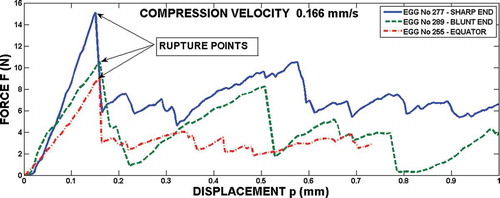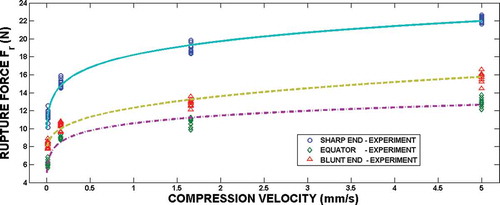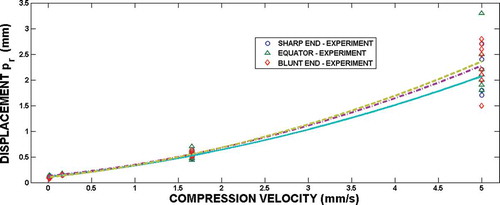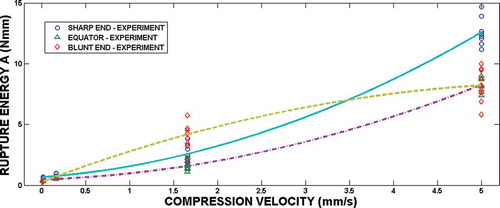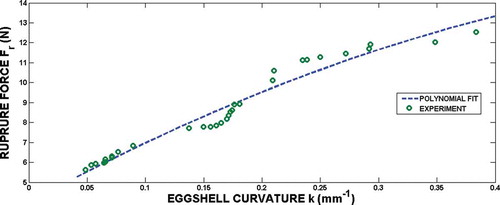Abstract
In this study, the mechanical behaviour of Japanese quail eggs was determined in terms of average rupture force, deformation, and energy absorbed during fracture. Eggs were characterized by some physical and geometrical properties, such as mass, length, width, eggshell thickness, geometric mean diameter, surface area, sphericity, volume, and eggshell radii of curvature. Egg samples were compressed along the axis of their symmetry (X axis) and perpendicularly to this axis (Z axis). Four different compression rates were used: 0.0166, 0.166, 1.666, and 5 mm/s. The highest rupture force, deformation at the egg’s rupture, and energy absorbed up to the fracture were found when Japanese quail eggs were loaded along their X-axis. The rupture force increased with the compression (loading) rate. The rate sensitivity of the eggshell rupture force was close to that observed for the hen’s eggs.
INTRODUCTION
Egg can be considered as a packaged food, and an important quality aspect of the packaged egg material is the mechanical strength of the eggshell. Eggshells must be strong enough to prevent cracking in order to preserve the embryo until hatching. Shell strength is also necessary to prevent damage from handling and to preserve eggs during transport from the farm to market. Most of the research has been performed on the eggshell strength of hen eggs.[Citation1CitationCitation−Citation4] The various egg physical properties, such as egg mass and volume, surface area, shell thickness, and weight, affect the mechanical properties of hens’ eggs. These physical properties of eggs and their resistance to damage through mechanical shock can be characterized by measures, such as rupture force, specific deformation, and rupture energy.[Citation3,Citation5,Citation6] The eggshell strength is also highly dependent on compression velocity.[Citation3,Citation6,Citation7] Altuntas and Sekeroglu[Citation3] and Nedomová et al.[Citation8] also investigated the effect of egg shape on the mechanical behaviour of chicken eggs under a compression load.
At the same time, the data on the physical properties and mechanical behaviour of Japanese quail eggs are very scarce in the literature. The most comprehensive data are given, e.g., by Polat et al.[Citation9] The objective of this study was to determine some main features of the mechanical behaviour of Japanese quail eggs at compression loading. The mechanical properties of quail eggs to compression were determined in terms of average rupture force, deformation, and rupture energy along X-front, X-back, and Z-axes. These properties were determined at different rates of compression: 0.0166, 0.166, 1.666, and 5 mm/s. As a part of this study, the eggshell geometry has been described in terms of size, geometric mean diameter, sphericity, volume, surface area, and radii of the eggshell surface curvature. The knowledge of the radius of the curvature is a very important quantity as discussed, e.g., by Nedomová et al.[Citation8]
MATERIALS AND METHODS
The eggs of wild-type, European-originated quails were obtained from the quail-breeding unit at the southeast part of the Czech Republic. The average air temperature and relative humidity were 17°C and 56% during the time period when the eggs were collected. The quails were 10 weeks old. The length, L, and width (thickness), W, of the quail eggs were measured by a dial micrometer with an accuracy of 0.001 mm. To obtain the unit mass of the quail eggs, they were measured by an electronic balance with an accuracy of 0.001 g. The geometric mean diameter (Dg) of the quail eggs was calculated by using the following relationships (Mohsenin):[Citation10]
The degree of sphericity of Japanese quail eggs can be expressed as follows:
The eggshell shape has been described using the shape index (SI), which is defined as:
In order to obtain a more detailed description of the eggshell shape, digital photos of the eggs have been performed. The image analysis performed using the software MATLAB version 7.12.0.635(R 2011a) (The MathWorks, Inc., USA) has been used for the evaluation of the coordinates xi and yi of the egg contour. This procedure is described by Severa et al.[Citation11] The obtained data have been used for the evaluation of the radii of the curvature, R, egg volume, V, and egg surface, S. A testing machine TIRA TEST (model 27025, TIRA GmbH, Schalkau, Germany) was used to determine the mechanical properties of the eggs tested. This testing machine enables to keep the constant speed of the moving plate from 0.0166 up to 13.33 mm/s. The maximal velocity is applicable only in tension mode. At the compression mode it is difficult, if not impossible, to keep constant velocity of the moving plate above 5–6 mm/s. The egg sample was placed on the moving platform and loaded at four compression speeds (0.0166, 0.166, 1.666, and 5 mm/s) and pressed with a plate fixed on the load cell until the egg ruptured. In this research, a sample of 240 eggs total were used. Results were analyzed using analysis of variance according to significant level (p < 0.05 and p < 0.01) and the means were compared using the LSD test as described by Gomez and Gomez.[Citation12] The statistical toolbox of MATLAB software was used. The fitting of the experimental data was performed using the “curve fitting toolbox” of the same software.
TABLE 1 Physical properties of Japanese quail egg (radii of curvature: R1—sharp end, R2—blunt end, R3—equator; eggshell thickness: t1—sharp end, t2—blunt end, t3—equator)
RESULTS AND DISCUSSION
The measured physical properties of the quail eggs are presented in . These properties are very similar to those reported by Polat et al.[Citation9] The average volume of egg found by Polat et al.[Citation9] is significantly lower than that reported in . The mean volume of quail egg found by Polat et al.[Citation9] was 359.27 mm3. This value is probably a consequence of some mistake during volume evaluation. Two compression axes (X and Z) for the egg were used in order to determine the rupture force, deformation, and energy absorbed up to the eggshell rupture (see ). The X-axis was the loading axis through the length dimension, and the Z-axis was the transverse axis containing the width dimension. An example of the experimental record force F—displacement p is displayed in . The force increases to a maximum, which corresponds to the rupture force Fr at which fracture of the eggshell occurs. A corresponding displacement pr is sometimes termed as the deformation. This quantity can be also expressed in dimensionless form:
FIGURE 1 Schematic of the quail eggs compression. The left side describes the loading along the X axis. The two arrangements are considered: Xs—The sharp end is in contact with the moving plate; Xb—The blunt end is in contact with the moving plate. The right side corresponds to the loading along the Z axis.
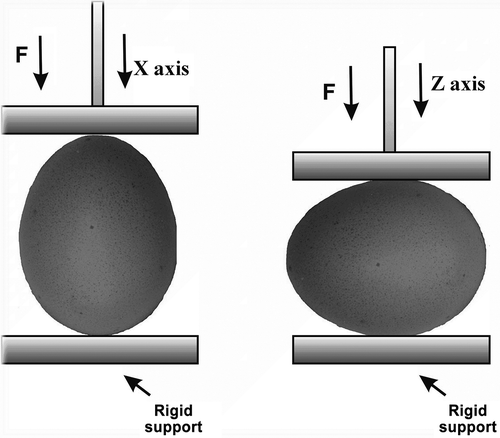
The nonzero value of the force after the eggshell fracture is given by the strength of the egg membranes. The next parameter describing the mechanical behaviour of egg is the energy absorbed up to the eggshell fracture. This energy was determined by calculating the area under the force-deformation curve from the following equation:
The example shown in indicates that the value of the rupture force depends on the loading orientation. The orientation of loading axis also influences the measure of nonlinearity of the F(p) dependence. This conclusion is different from that obtained for the hen eggs where the dependence of the force on the displacement is linear up to the rupture force independently on the loading orientation.
The rupture force increases with the compression velocity (see ). The loading orientation with the least resistance to the rupture is the Z-axis. The highest rupture forces are required when loading the Xs axis. The deformation pr increases with the compression rate (see ). The effect of compression axes on rupture force was also significant. The rupture force Fr rapidly increases with the compression velocity, namely, at low values of this parameter. The rupture energy A increases with the compression rate. The effect of the compression velocity is significant (p < 0.1). The rupture energy also depends on the compression axes (see ).
The analysis of experimental data showed that the effect of the compression velocity, v, on rupture force, deformation, and rupture energy can be described by the functions:
Rupture force:
Deformation:
Rupture energy:
where [v] = mm/s. Parameters of these functions are given in . The results on mechanical behaviour of quail eggs were obtained by Polat et al.[Citation9] These data were obtained at compression velocity 0.13 mm/s. The rupture force exhibited the same dependence on the compression axis as it was found in the present article. The highest value of this force was 10.51 N. The lowest value was found to be 6.83 N. Results reported in the given article show that at the compression velocity of 0.166 mm/s the values of the rupture forces lie between 9 and 11.4 N. Our results are in reasonable agreement with Polat et al.[Citation9]
The increase of the rupture force with compression rate has been observed for many different materials (see, e.g., Meyers[Citation13]). The physical interpretation of this phenomenon is known for metallic materials, polymers, and for some ceramics. The first explanation of the mechanism of the eggshell strength dependence on the loading rate (e.g., on the compression velocity) was probably given by Carter.[Citation14] Carter considered the effect of loading rate as the period of time over which a load is applied. The decrease in strength of an eggshell, which accompanies an increasing of the period mentioned above, might come about by either of two mechanisms: a decrease in the strength of the material constituting the strong, outer layer of the mineral shell, or a decrease in the thickness of this layer brought about by deepening of the crevices that are normally present between adjacent crystal columns in the weak, inner layer of the shell. The experiments described in the cited paper indicate the dominant role of the second mechanisms. This mechanism explains many phenomena like delayed fracture, etc. The use of this model to the interpretation of our results was not successful. In order to obtain some insight on this problem, it is reasonable to take into account the behaviour of the outer layer of the mineral shell under mechanical loading. This layer exhibits similar features of many ceramics. The effect of the loading rate on the fracture of ceramics and generally brittle materials is described in many papers, see, e.g., Johnson and Holmquist.[Citation15] The application of the corresponding constitutive equations to the description of the eggshell behaviour is difficult because there is nearly no chance to produce some specimen for simple mechanical tests. These tests are necessary for the evaluation of the constitutive equations’ parameters. The only chance represents the use of the constitutive equation with some default parameters for the numerical simulation of the eggshell compression (static and/or dynamic, respectively). The mutual comparison between numerical results and experiments can be used for the evaluation of reliable parameters of the constitutive equations. The dependence of the eggshell fracture parameters on the loading orientation can be partially explained by the egg shape. In ASAE,[Citation16] the method for compression tests of food materials of convex shape is described. According to this theory, the loading force depends on the main curvature of the eggshell. If we denote the radii of the curvature at the sharp end as R1, at the blunt end as R2, and at the equator as R3, then for the loading in the Xs, Xb, and Z axes, we obtain the curvatures k1, k2, and k3:
Parameters of Eq. (9) are given in . The sensitivity of the rupture force to the compression velocity can be characterized by the parameter:
TABLE 3 Parameters of Eq. (9)
This quantity can also be used for a comparison of the rate sensitivity of the rupture force for the different eggs. The increase of the rupture force with the compression velocity has been also observed for hens’ eggs, e.g., by Trnka et al.[Citation7] This dependence was fitted by the function:
The rate sensitivity is then given as:
Rate sensitivity of the eggshell rupture force is very similar both for hen eggs and quail eggs (see ). Rate sensitivity decreases with the compression velocity. The highest sensitivity of the rupture force occurs for the loading of the egg along its asymmetry axis (Xs). The rate sensitivity for both deformation, pr, and rupture energy, A, increases with the compression velocity.
CONCLUSIONS
The results indicated that the mechanical properties are highly dependent on compression velocities. Rupture force increases with the compression velocities for all orientations of egg loading. The rupture force observed for eggs compressed along the Xs axis were higher than the values obtained for the Xb and Z orientation. The effect of the loading orientation has been quantitatively described using the main eggshell curvature at the point of contact between egg and moving plate. The displacements at the eggshell fracture and rupture energy values observed for eggs compressed along the Xs-axis were also higher than the values obtained when testing eggs in the Xb and Z orientations. The sensitivity of the rupture force to the compression velocity decreases with this velocity. The same tendency was found for the hen’s eggs. Even if the rupture forces of hen’s eggs are significantly higher than those found for the quail eggs, the differences in the rate sensitivities of the rupture force are relatively very low. Compression of the hen’s eggs is typical by the linear dependence of the loading force on the displacement up to the eggshell rupture. The same function observed for the quail eggs is generally nonlinear, namely, for the higher values of loading rate.
FUNDING
The authors gratefully acknowledge the support of the Institute of Thermomechanics AS CR, v.v.i. of the Czech Academy of Sciences through institutional support No. RVO: 61388998. This work has also been supported by IP 2/2013 IGA MENDELU.
REFERENCES
- De Ketelaere, B.; Govaerts, T.; Couke, P.; Dewil, E.; Visseher, T.; Decuypere, L.; De Baerdemaeker, J. Measuring the eggshell strength of 6 different strains of laying hens: Techniques and comparison. British Poultry Science 2002, 43, 238–244.
- Narushin, V.G.; Van Kepmen, T.A.; Wineland, M.T.; Christensen, V.L. Comparing infrared spectroscopy and egg size measurements for predicting eggshell quality. Biosystems Engineering 2004, 87, 367–373.
- Altuntas, E.; Sekeroglu, A. Effect of shape index on mechanical properties of chicken eggs. Journal of Food Engineering 2008, 85, 606–612.
- MacLeod, N.; Bain, M.M.; Hancock, J.W. The mechanics and mechanisms of failure of hens’ eggs. International Journal of Fracture 2006, 142, 29–41.
- Richards, J.F.; Staley, L.M. The relationships between crushing strength, deformation and other physical measurements of the hen’s egg. Poultry Science 1967, 46, 430–437.
- Voisey, P.W.; Hunt, J.R. Effect of compression speed on the behaviour of eggshells. Journal of Agricultural Engineering Research 1969, 14, 40–46.
- Trnka, J.; Severa, L.; Nedomova, S.; Dvoraková, P. Effect of loading rate on hen’s eggshell mechanics. Journal of Food Research 2012, 1 (4), 96–105.
- Nedomová, Š.; Severa, L.; Buchar, J. Influence of hen egg shape on eggshell compressive strength. International Agrophysics 2009, 23 (3), 249–256.
- Polat, R.; Tarhan, S.; Çetin, M.; Atay, U. Mechanical behaviour under compression loading and some physical parameters of Japanese quail (Coturnix coturnix japonica) eggs. Czech Journal of Animal Science 2007, 52, 50–56.
- Mohsenin, N.N. Physical Properties of Plant and Animal Materials; Gordon and Breach Science Publishers: New York, NY, 1970.
- Severa, L.; Nedomova, S.; Buchar, J.; Cupera, J. Novel approaches in mathematical description of hen egg geometry. International Journal of Food Properties 2013, 16 (7), 1472–1482.
- Gomez, K.A.; Gomez, A.A. Statistical procedures for agricultural research. In: An International Rice Researches Institute Book, 2nd Ed.; Gomez, K.A.; Gomez, A.A.; Eds.; Wiley: USA and Canada, 1984; 137–186.
- Meyers, M.A. Dynamic Behavior of Materials; John Wiley and Sons, New York, NY, 1994.
- Carter, T.C. The hen’s egg: Evidence on the mechanism relating shell strength to loading rate. British Poultry Science 1979, 20 (2), 175–183.
- Johnson, G.R.; Holmquist, C.J. An improved computational constitutive model for brittle materials. In: High Pressure Science and Technology, Vol. 2; Schmidt, S.C.; Shaner, J.W.; Samara, G.A.; Ross, M.; Eds.; AIR Press, New York, 1993; 981–984.
- ASAE. ASAE S368.4: Compression test of food materials of convex shape. American Society of Agricultural Engineers: St. Joseph, MI, USA, 2001.

